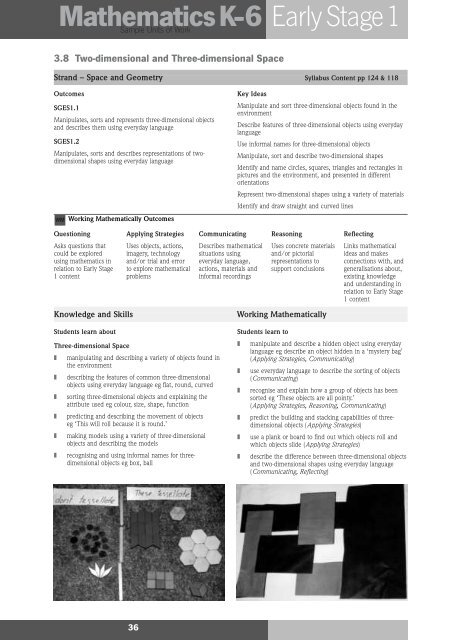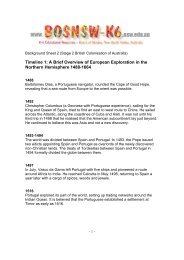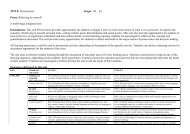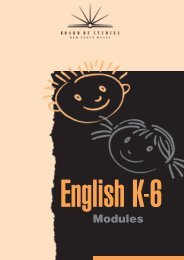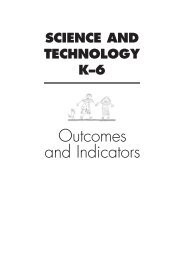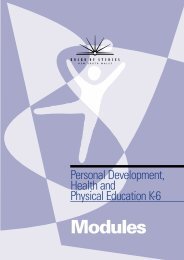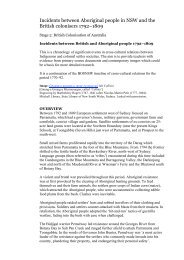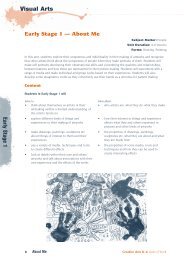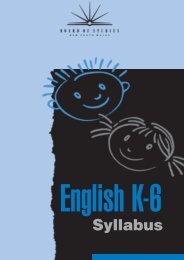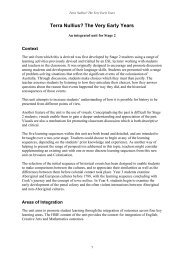Math K-6 WS - K-6 Educational Resources
Math K-6 WS - K-6 Educational Resources
Math K-6 WS - K-6 Educational Resources
You also want an ePaper? Increase the reach of your titles
YUMPU automatically turns print PDFs into web optimized ePapers that Google loves.
<strong>Math</strong>ematicsK-6 Early Stage1<br />
3.8 Two-dimensional and Three-dimensional Space<br />
Strand – Space and Geometry Syllabus Content pp 124 & 118<br />
Outcomes<br />
SGES1.1<br />
Manipulates, sorts and represents three-dimensional objects<br />
and describes them using everyday language<br />
SGES1.2<br />
Manipulates, sorts and describes representations of twodimensional<br />
shapes using everyday language<br />
WM<br />
Questioning<br />
Asks questions that<br />
could be explored<br />
using mathematics in<br />
relation to Early Stage<br />
1 content<br />
Students learn about<br />
Three-dimensional Space<br />
Sample Units of Work<br />
Working <strong>Math</strong>ematically Outcomes<br />
Applying Strategies<br />
Uses objects, actions,<br />
imagery, technology<br />
and/or trial and error<br />
to explore mathematical<br />
problems<br />
❚ manipulating and describing a variety of objects found in<br />
the environment<br />
❚ describing the features of common three-dimensional<br />
objects using everyday language eg flat, round, curved<br />
❚ sorting three-dimensional objects and explaining the<br />
attribute used eg colour, size, shape, function<br />
❚ predicting and describing the movement of objects<br />
eg ‘This will roll because it is round.’<br />
❚ making models using a variety of three-dimensional<br />
objects and describing the models<br />
❚ recognising and using informal names for threedimensional<br />
objects eg box, ball<br />
Communicating<br />
Key Ideas<br />
Describes mathematical<br />
situations using<br />
everyday language,<br />
actions, materials and<br />
informal recordings<br />
Manipulate and sort three-dimensional objects found in the<br />
environment<br />
Describe features of three-dimensional objects using everyday<br />
language<br />
Use informal names for three-dimensional objects<br />
Manipulate, sort and describe two-dimensional shapes<br />
Identify and name circles, squares, triangles and rectangles in<br />
pictures and the environment, and presented in different<br />
orientations<br />
Represent two-dimensional shapes using a variety of materials<br />
Identify and draw straight and curved lines<br />
Reasoning<br />
Students learn to<br />
Uses concrete materials<br />
and/or pictorial<br />
representations to<br />
support conclusions<br />
Knowledge and Skills Working <strong>Math</strong>ematically<br />
36<br />
Reflecting<br />
Links mathematical<br />
ideas and makes<br />
connections with, and<br />
generalisations about,<br />
existing knowledge<br />
and understanding in<br />
relation to Early Stage<br />
1 content<br />
❚ manipulate and describe a hidden object using everyday<br />
language eg describe an object hidden in a ‘mystery bag’<br />
(Applying Strategies, Communicating)<br />
❚ use everyday language to describe the sorting of objects<br />
(Communicating)<br />
❚ recognise and explain how a group of objects has been<br />
sorted eg ‘These objects are all pointy.’<br />
(Applying Strategies, Reasoning, Communicating)<br />
❚ predict the building and stacking capabilities of threedimensional<br />
objects (Applying Strategies)<br />
❚ use a plank or board to find out which objects roll and<br />
which objects slide (Applying Strategies)<br />
❚ describe the difference between three-dimensional objects<br />
and two-dimensional shapes using everyday language<br />
(Communicating, Reflecting)


